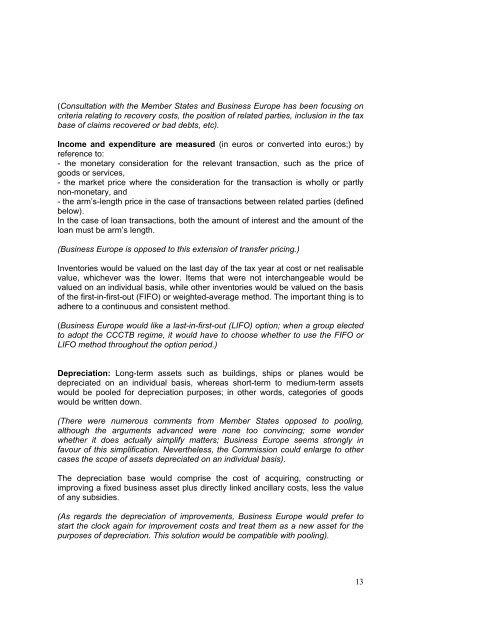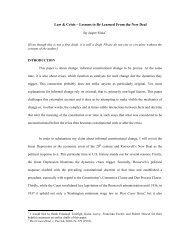An outline of the CCCTB (Common Consolidated Corporate Tax ...
An outline of the CCCTB (Common Consolidated Corporate Tax ...
An outline of the CCCTB (Common Consolidated Corporate Tax ...
Create successful ePaper yourself
Turn your PDF publications into a flip-book with our unique Google optimized e-Paper software.
(Consultation with <strong>the</strong> Member States and Business Europe has been focusing on<br />
criteria relating to recovery costs, <strong>the</strong> position <strong>of</strong> related parties, inclusion in <strong>the</strong> tax<br />
base <strong>of</strong> claims recovered or bad debts, etc).<br />
Income and expenditure are measured (in euros or converted into euros;) by<br />
reference to:<br />
- <strong>the</strong> monetary consideration for <strong>the</strong> relevant transaction, such as <strong>the</strong> price <strong>of</strong><br />
goods or services,<br />
- <strong>the</strong> market price where <strong>the</strong> consideration for <strong>the</strong> transaction is wholly or partly<br />
non-monetary, and<br />
- <strong>the</strong> arm’s-length price in <strong>the</strong> case <strong>of</strong> transactions between related parties (defined<br />
below).<br />
In <strong>the</strong> case <strong>of</strong> loan transactions, both <strong>the</strong> amount <strong>of</strong> interest and <strong>the</strong> amount <strong>of</strong> <strong>the</strong><br />
loan must be arm’s length.<br />
(Business Europe is opposed to this extension <strong>of</strong> transfer pricing.)<br />
Inventories would be valued on <strong>the</strong> last day <strong>of</strong> <strong>the</strong> tax year at cost or net realisable<br />
value, whichever was <strong>the</strong> lower. Items that were not interchangeable would be<br />
valued on an individual basis, while o<strong>the</strong>r inventories would be valued on <strong>the</strong> basis<br />
<strong>of</strong> <strong>the</strong> first-in-first-out (FIFO) or weighted-average method. The important thing is to<br />
adhere to a continuous and consistent method.<br />
(Business Europe would like a last-in-first-out (LIFO) option; when a group elected<br />
to adopt <strong>the</strong> <strong>CCCTB</strong> regime, it would have to choose whe<strong>the</strong>r to use <strong>the</strong> FIFO or<br />
LIFO method throughout <strong>the</strong> option period.)<br />
Depreciation: Long-term assets such as buildings, ships or planes would be<br />
depreciated on an individual basis, whereas short-term to medium-term assets<br />
would be pooled for depreciation purposes; in o<strong>the</strong>r words, categories <strong>of</strong> goods<br />
would be written down.<br />
(There were numerous comments from Member States opposed to pooling,<br />
although <strong>the</strong> arguments advanced were none too convincing; some wonder<br />
whe<strong>the</strong>r it does actually simplify matters; Business Europe seems strongly in<br />
favour <strong>of</strong> this simplification. Never<strong>the</strong>less, <strong>the</strong> Commission could enlarge to o<strong>the</strong>r<br />
cases <strong>the</strong> scope <strong>of</strong> assets depreciated on an individual basis).<br />
The depreciation base would comprise <strong>the</strong> cost <strong>of</strong> acquiring, constructing or<br />
improving a fixed business asset plus directly linked ancillary costs, less <strong>the</strong> value<br />
<strong>of</strong> any subsidies.<br />
(As regards <strong>the</strong> depreciation <strong>of</strong> improvements, Business Europe would prefer to<br />
start <strong>the</strong> clock again for improvement costs and treat <strong>the</strong>m as a new asset for <strong>the</strong><br />
purposes <strong>of</strong> depreciation. This solution would be compatible with pooling).<br />
13
















